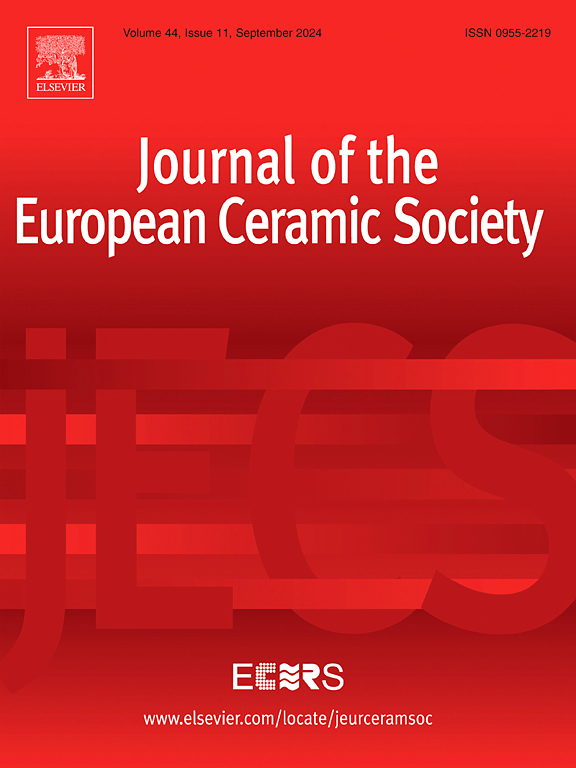Preparation and oxidation properties of tantalum-based Yb2O3 modified MoSi2 ceramic coating
IF 6.2
2区 材料科学
Q1 MATERIALS SCIENCE, CERAMICS
Journal of The European Ceramic Society
Pub Date : 2025-05-20
DOI:10.1016/j.jeurceramsoc.2025.117546
引用次数: 0
Abstract
The high-temperature oxidation susceptibility of tantalum-based alloys severely limits their engineering applications in elevated-temperature environments. In this study, a Yb2O3-modified MoSi2 composite ceramic coating was successfully fabricated on a tantalum substrate through a two-step process combining slurry sintering and embedded siliconization, with systematic investigation of its ultra-high-temperature oxidation resistance and failure mechanisms. The ceramic coating exhibits a gradient structure comprising a Yb2O3-MoSi₂ main layer, a TaSi₂ diffusion layer, and a Ta₅Si₃ transition layer. Under ultra-high-temperature oxidation at 1800 °C, the ceramic coating demonstrates an effective protection duration of 5.5 h. The continuous SiO₂ glass film formed synergistically inhibits oxygen permeation with Yb₂Si₂O₇/Yb₂SiO₅ silicates. Yb³⁺ stabilizes the SiO₂ network structure by reducing non-bridging oxygen content, thereby enhancing oxide film viscosity and impeding oxygen diffusion. This research provides new insights into the compositional design and performance optimization of ultra-high-temperature protective ceramic coatings, advancing the application of tantalum-based materials in aerospace and energy-related fields.
钽基Yb2O3改性MoSi2陶瓷涂层的制备及其氧化性能
钽基合金的高温氧化敏感性严重限制了其在高温环境中的工程应用。本研究通过浆料烧结和嵌套硅化两步工艺,在钽基体上成功制备了yb2o3改性MoSi2复合陶瓷涂层,并对其超高温抗氧化性能和失效机理进行了系统研究。陶瓷涂层呈现梯度结构,包括Yb2O3-MoSi₂主层,TaSi₂扩散层和Ta₅Si₃过渡层。在1800℃的超高温氧化条件下,陶瓷涂层的有效保护时间为5.5 h。形成的连续SiO₂玻璃膜与Yb₂Si₂O₇/Yb₂SiO₅硅酸盐协同抑制氧气渗透。Yb³⁺通过降低非桥氧含量来稳定SiO₂网络结构,从而提高氧化膜粘度,阻碍氧气扩散。该研究为超高温防护陶瓷涂层的成分设计和性能优化提供了新的见解,推动了钽基材料在航空航天和能源相关领域的应用。
本文章由计算机程序翻译,如有差异,请以英文原文为准。
求助全文
约1分钟内获得全文
求助全文
来源期刊

Journal of The European Ceramic Society
工程技术-材料科学:硅酸盐
CiteScore
10.70
自引率
12.30%
发文量
863
审稿时长
35 days
期刊介绍:
The Journal of the European Ceramic Society publishes the results of original research and reviews relating to ceramic materials. Papers of either an experimental or theoretical character will be welcomed on a fully international basis. The emphasis is on novel generic science concerning the relationships between processing, microstructure and properties of polycrystalline ceramics consolidated at high temperature. Papers may relate to any of the conventional categories of ceramic: structural, functional, traditional or composite. The central objective is to sustain a high standard of research quality by means of appropriate reviewing procedures.
 求助内容:
求助内容: 应助结果提醒方式:
应助结果提醒方式:


